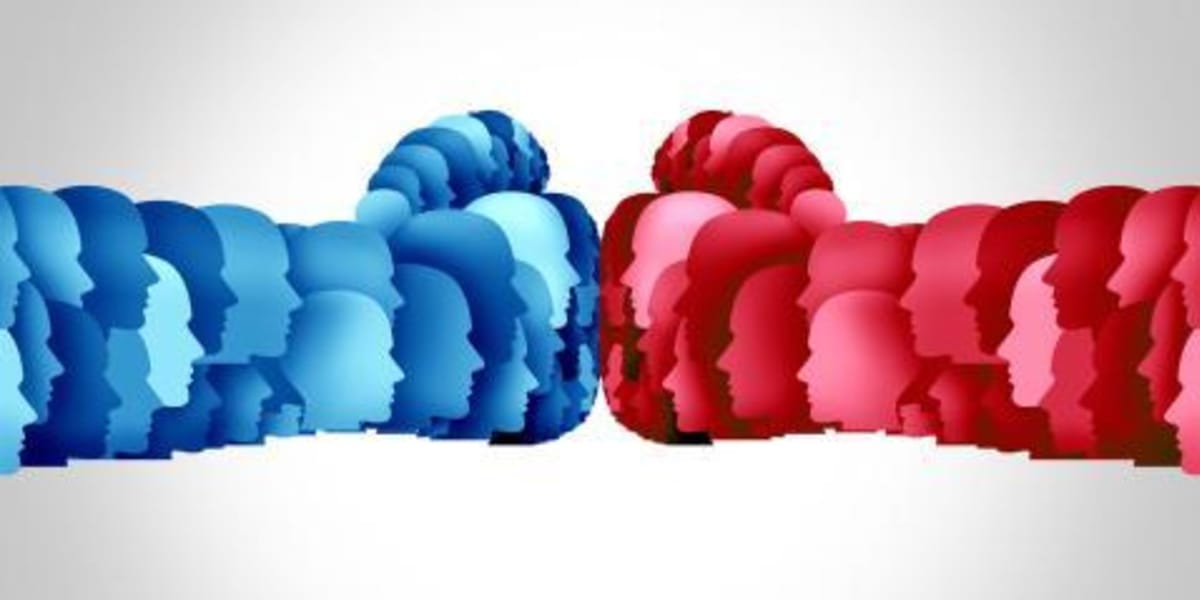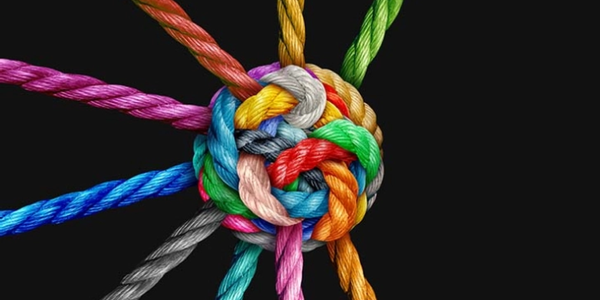Party and ideology in 2025
Who does the hyperpolarized, hyperpartisan narrative in American politics really benefit? And is it getting in our way of something better...

Last week as part of my essay on how we expand both the idea and the practice of the Democratic Party, I focused on some new ways to think about people and about the complex, interconnected communities of allies that might could make up a much broader Party. That breadth and pluralism is an essential and fundamental source of the creativity and adaptability our country (and the world) desperately needs in this moment. Retreating into or accepting the familiar, simpler us-vs-them dynamics that a reactive posture of constant response to the Trump Administration's cruelty will only enable/embody/cement the small, narrow framing that the hyperpolarization narrative encourages. If we live in that reactive response posture, we will be defined by it in small, confining ways that ensure that we do not manage to unite labor movements with social justice movements with innovation with creator movements into the majority Party the country needs us to become.
Into this complicated moment, enter Gallup and their long-running polls on party affiliation and ideological identification in America. This research attempts to help quantify and contextualize the partisan experience of modern American civic life through it's longitudinal view of both party and ideology in America. And while there are lessons to learn from this data, ultimately the story this tells about where we need to go is incomplete at best and genuinely misleading at worst.
Seeing just over half the country affiliating with either major political party makes it easy to conclude that a huge swath of Americans either don't align with or don't see our major parties as meaningful places to center their political identifies or engage in their civic life. (And there are lots of other structural conclusions to consider about our two-party duopoly that I'm going to leave for another day.) But it's the ideology survey that really raises important questions for me about whether the stale hyperpolarized, hyperpartisanship narrative or confining bipolar spectrum of the Left-Right frame really does almost anything to help explain our world – and may in fact be hurting our ability to see others as allies.
If we look at the Liberal-Moderate-Conservative numbers overall as aggregates of how party respondents respond in combination with the party affiliation data from the party poll we get:
Liberal = 28*55%+43*20%+28*4% = 25.12%
Conservative = 28*77%+43*30%+28*9% = 36.98%
These sums are roughly the same numbers we see in the aggregate national sets in the ideology study (which is what we'd expect). But seeing them in their component party affiliation subgroups invites a series of questions: do we really believe that people who still identify as members of the Republican party are using the word "liberal" the same way members of the Democratic Party do? How much is that a relative measure within the GOP? Or is there something more consistent culturally that both are tapping into and identifying with? Do we really believe that people who still identify as members of the Democratic Party are using the word "conservative" the same way members of the GOP do? Or is there a social psychology of association at work in how people identify and are expected to identify within a Party?
It would also be easy to look at this data and say the Democratic Party has drifted toward being more and more liberal over the last 30 years much faster (+120% increase) than the GOP has drifted toward Conservatism (+33%) and conclude that since only 20% of Independents identify as liberal and a full 45% as moderate that a broader Democratic Party must embrace some milquetoast centrist posture to grow ambitiously.
But if we acknowledge at any level that these abstractions have cultural value at least as significant as their value as guiding political philosophy concepts, we need to consider the possibility of a different conclusion.
Concepts like "liberal" and "conservative" have roots in well-understood political science and philosophy, but have become cultural abstractions that have more cultural signaling power and value than they do definitional meaning and those cultural definitions that shift and drift both over time and within communities. Despite Gallup's best efforts to ask consistent questions over time, it's not likely that we are comparing apples to apples in these trends or across these groups. I might suggest a couple alternative ways to interpret this data that the conflict-dependent information systems we rely on for news and information aren't incentivized to explore.
One, that if these words mean different things within different cultural groups, then not only is treating the whole groups as homogenous already a recipe for failure, but aggregating ideological perspectives across groups as part of any strategy is a huge potential blunder. Looking for cultural similarities across these groups at the individual level is likely to be much more fruitful in leaving behind these polar constraints and make building a much larger coalition much more likely than holding on to any misguided assumption about them at the aggregate level. People who do not want to affiliate with a political party sometimes avoid them because of a desire for heterogeneity, pluralism, and a reduction in extremism of tone and posture to political opposition that each party often defines as enemies. It's often the tone, posture, and the strength of opinions that people reject before anything having to do with ideology much less policy. It's about how we are in our civic lives, more than what we are, what we believe, or what we want.
Two, that if that variation within and between groups is accurate, then the Party affiliation numbers actually might be a good guide to the community that we ought to be trying to build our majority Party from. If we listen carefully to the ways that people who don't identify with the GOP use theses ideological abstractions and what they are actually identifying about their experience and preferences, especially the word "moderate" and look for ways that they are aligned culturally with the desire to build a society where people are actively engaged in caring for, supporting, and elevating others, then I think we are likely to find that that most of the 44% of the 43% Independents who self-identify as Moderate are well-aligned with a worldview that supports the kind of country the Democratic Party is trying to build. And if we do that math (IndMod + IndLib + GOPLib) plus Dems we might already be pushing toward 60% of the country.
What the Trump Administration is doing must be opposed, consistently and tirelessly, regardless of fatigue, regardless of how much damage is already done. Damage is both the strategy and the goal of an Administration that claims a mandate for undermining government.
As Antonia Scatton put it this morning: "What Trump is doing is morally wrong. By trying to undo the work of the federal government, he's overriding the collective decisions of generations of Americans about how we want to keep each other safe, improve our quality of life and meet each other’s most fundamental needs.
Cruelty and immorality must be opposed and must be called out vociferously to be certain we are clearly defining what is immoral, unethical, and unacceptable in our small "d" democratic culture. But we cannot allow ourselves (or our opposition) to be defined by our opponent's billionaire agenda and their dangerous scapegoating of the vulnerable. To strengthen society and build a bigger, broader Democratic Party, we must proceed to define ourselves in explicit moral and cultural axes (rather than the lazy abstraction shorthand of party and ideology) and on our own terms – that government is a tool we use to empower and to take care of everyone. And then we can work towards that 60% on a commitment to listen, to hear, and to be different in our ways of engaging with others, and pull the country toward something kinder, more just, and more generative – and leave this assumption of polarization and partisanship that isn't serving us behind as we try to build toward something better.
Last updated: 30 Jan 2025




